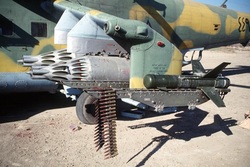Weapons In The Soviet/Afghanistan War
With the first invasion on Christmas night, 1979, a war was started between Afghanistan Muslims and the Communist Russians. This began a new age where a world power, that had the most advanced weaponry the world offered, could be defeated and pushed out of a country by mere assault rifles and proper knowledge of the terrain. With the aid of only two man-portable weapons the Mujahdeen pushed out the largest, and second strongest country in the world.
Mujahdeen
Thousands of Afghan Muslims joined the Mujahdeen after they declared a holy war on the Amin Government during the Soviet/Afghan war. This was because Amin wanted a communist government which didn't incorporate religion and Muslim ideals which the good portion of the Country believed in at the time, and still do now. This holy war entitled violence against the government leaders as well as any one that helped their cause, which included Russian insurgents (Trueman, 2005). The Mujahdeen were only equipped with old rifles and Ak-47's at the time making them seem like an inferior gorilla task force to the Soviets (Trueman, 2005). But the Soviets soon found out it would be harder than they originally thought to defeat the "terrorists". The Mujahdeen had the Knowledge of the mountains which enabled them to traverse the very inhospitable terrain that tore at the Soviet forces (Trueman, 2005). They used this knowledge in combination with weapons retrieved from other nations. The Afghans were provided with American surface-to-air missiles (Trueman, 2005) and the Kalashnikov Assault Rifle (AK-47) was used as well (Grau, 2004). In the 1960's the Soviet Union built Airfields in the North end of the Country of Afghanistan enabling the construction of bases; The Pakistani ISI, United States and Britain provided training as well (Grau, 2004). SA-7's, Stinger's and "heavy weapons" were also used by this faction (McGhee, 2008).
AK-47
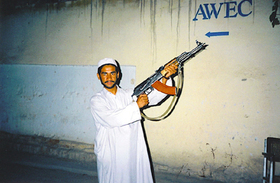
This gun is one of the most widely used weapons in the world, put into use by more than 50 armies and has since become a standard weapon for guerilla warfare and westernized countries alike. The gun has a 7.62mm round and holds 30 in a magazine. The magazine can be switched to a drum or box magazine to hold more though. It fires at 600 rounds per minute and can be combined with almost any weapon attachment available. The weapon is also extremely durable, resisting mud, ice, and sand, it can even fire after coming out of water. Because of the weapons wide use and massive production, the Afghans could find it, or buy it, almost anywhere. This makes the AK-47 a prime weapon for a guerilla force.
Stinger Missile
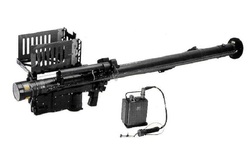
'Under great pressure from members of the Departments of State and Defense, the delivery of the first 150 U.S. made Stinger Missiles were delivered to the Mujahdeen" (McGhee, 2008). U.S. made man-portable system, weighs 34 pounds, is 5 feet long, and has a maximum range of 5,800 meters and maximum altitude of 3,500 meters (McGhee, 2008). The stinger missle was fear inducing as well. The Soviet pilots were less inclined to do missions in areas that the stinger missle was thought to be (McGhee, 2008). This also forced the Soviets to deploy their helicopters at night and less during the day (McGhee, 2008).
SA-7

This weapon was gained by the Afghan forces by recovery efforts of the Soviet weapons. Also there is small indications that America and Britain sold them the weapons as well, but that is disputed (Grau, 2004). The missile launched at a speed of 580m/s and fueled itself with with a solid fuel booster. The weapon is also armed in the nose with a Passive IR homing device. The missile either makes flush or grazing contact to ignite the warhead or self destructs after 15 seconds. (SA-7, 1999)
Soviet Forces
The Soviet Forces in the war were much more armed than the Mujahdeen. They had the Spetsnaz (which is basically Navy Seals for the Russians) (Grau, 2004), napalm, poison gas, anti-personnel mines, bombers, smoke-screens, and helicopter gun ships (Trueman, 2005). The Soviets would employ their weapons with brutal tactics. For example: The Afghans were injured by the landmines primarily so the helicopters could kill them easier. Helicopter Strength of the Soviets ranged from 500-650 (Nelson, 1985). The Russians had a heavy fleet of aircraft like the Mi-4 Hounds, MiG-21 Fishbed, Su-25, Su-17 Fitter, Su-24 Fencer, and MiG-23 Flogger (Nelson, 1985). They used SA-7 portable SAMs, grenade launchers, sniper rifles, mortars, AA guns as well as the AK-74 rifle with their military personnel as well (Nelson, 1985).
Mi-24 Hind Gunship
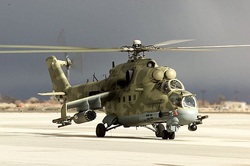
The M1-24 Hind Gunship was the most used helicopter with which they had 250 out of the 500 available helicopters in their fleet (Nelson, 1985). This gunship is able to carry 7 troops or 14 stretchers (MI-24, 2005). It weighs 8200kg and can fly with up to 26,455kg of weight (MI-24, 2005). It also holds the land-speed record for active duty helicopters to this very day (MI-24, 2005). During the war they used a 21.7mm cannon and a 12.7mm, four barrel, gun-pod. The Hind saw a lot of action from the stingers that the Afghans used but they had a way around that situation (MI-24, 2005). When the Hind gunship would enter an area that might contain an ambush they would first send in 3 or 4 Mi-4 Hounds which would lay down initial fire and heat flares which would misdirect the stinger missiles (Nelson, 1985). After which the Hind Gunship would lay down as much fire as needed until the threat was gone (Nelson, 1985). The helicopter can also hold 4 anti-tank missiles, rocket pods, and door-mounted machine guns making it one of the Soviets most formidable weapons during the war (MI-24, 2005).
Mi-4 Hound
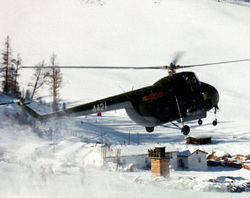
This helicopter can Transport 12-16 equipped troops (MI-4, 2007). It also has a machine gun pod and small rockets. (MI-4, 2007) The machine gun was mounted under the helicopter as depicted (MI-4, 2007).
Tu-16 Badger
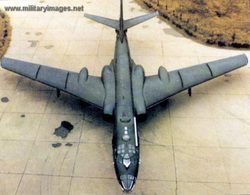
This is the Tu-16 Badger which is a medium-range bomber that can carry up to a 19,800 pound bomb-load and function up to 40,350 feet above sea level (Nelson, 1985). The guerrilas had no weaponry that could reach the altitude of the bombers so they were relatively safe in this plane (Nelson, 1985). They have used this bomber to drop enhanced-blast bombs and large blockbuster bombs (Nelson, 1985).
MiG-21 Flogger
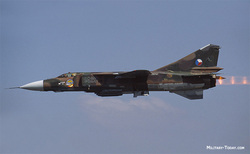
The MiG-21's had one twin barrel 23mm gun with 200 rounds of ammunition, it could carry 57-mm rocket packs, two 500-kg bombs, and two 250-kg bombs or four 240mm air-to-surface rockets (Nelson, 1985).
500kg Bombs
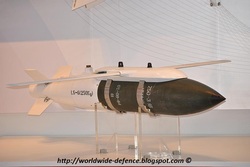
These were heavily used by the Soviets in their bombers through out the Soviet/Afghan War (Nelson, 1985). They would do extremely heavy bombings on cities where almost everything was turned to rubble (Nelson, 1985). After the bombings would stop, troops would enter the cities and kill anything that still lived, essentially turning everything of value into rubble (Nelson, 1985).
Blockbuster Bombs
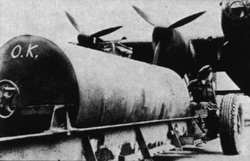
These were 8,000 to 12,000 pound bombs that contained three separate impact fuses to guarantee the detonation. They were built with a very thin shell to fit almost 3/4 of the weight of explosives into the bomb. These bombs were mainly used to detonate mid-air and cause a massive shock wave. This shock wave would then kill by concussion within the immediate vicinity (Nelson, 1985).
Vintorez Russian Sniper Rifle
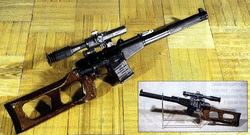
The Spetsnaz used this gun along with other hand guns, machine guns, grenade launchers, and assault rifles during this war. This weapon has a 39mm round and can carry 9 in a clip. It had an effective range of 400m and had a suppressor. The rounds they used for the gun had no flash and they used a night vision scope for poorly lit missions (Vintorez, 2010).
AK-74

The AK-74's were a better option than the AK-47 during the Soviet/Afghan war because of its light weight and smaller rounds. The enemy did not have much armor during this time so lightweight weapons became a key feature for the soviet arms choice. The weapons used a 5.45mm round with a 30 round clip capacity (Popenker, 2010).
Sources
- Trueman, C. (2005). Russian Invasion of Afghanistan. In History Learning Site. Retrieved September 23, 2011, from http://www.historylearningsite.co.uk/russia_invasion_afghanistan.htm
- Nelson, L. R. (1985, February). Soviet Air Power: Tactics and Weapons Used in Afghanistan. In Air University Review. Retrieved September 23, 2011, from http://www.airpower.maxwell.af.mil/airchronicles/aureview/1985/jan-feb/nelson.html
- Grau, L. W. (2004, March). The Soviet-Afghan War: A superpower Mired In the Mountains. In The Journal of Slavic Military Studies. Retrieved September 23, 2011, from http://fmso.leavenworth.army.mil/documents/miredinmount.htm
- McGhee, M. T. (2008, June 14). The Soviet Experience in Afghanistan: Lessons Learned. In Military History Online. Retrieved September 23, 2011, from http://www.militaryhistoryonline.com/20thcentury/articles/sovietexperience.aspx
- MI-24 Hind A/D. (2005). In Gun Copter. Retrieved September 23, 2011, from http://www.guncopter.com/mi-24-hind/
- Mi-4 Hound. (2000, June 26). In Military Analysis Network. Retrieved September 23, 2011, from http://www.fas.org/man/dod-101/sys/ac/row/mi-4.htm
- Vintorez. (2010). In Enemy Forces. Retrieved September 23, 2011, from http://www.enemyforces.net/firearms/vss.htm
- Popenker, M. R. (2010). AK-74, AKS-74 and AK-74M assault Rifles (Russia). In World Guns. Retrieved September 24, 2011, from http://world.guns.ru/assault/rus/ak-74-e.html
- SA-7 Grail. (1999, March 21). In Military Analysis Network. Retrieved September 24, 2011, from http://www.fas.org/man/dod-101/sys/missile/row/sa-7.htm
